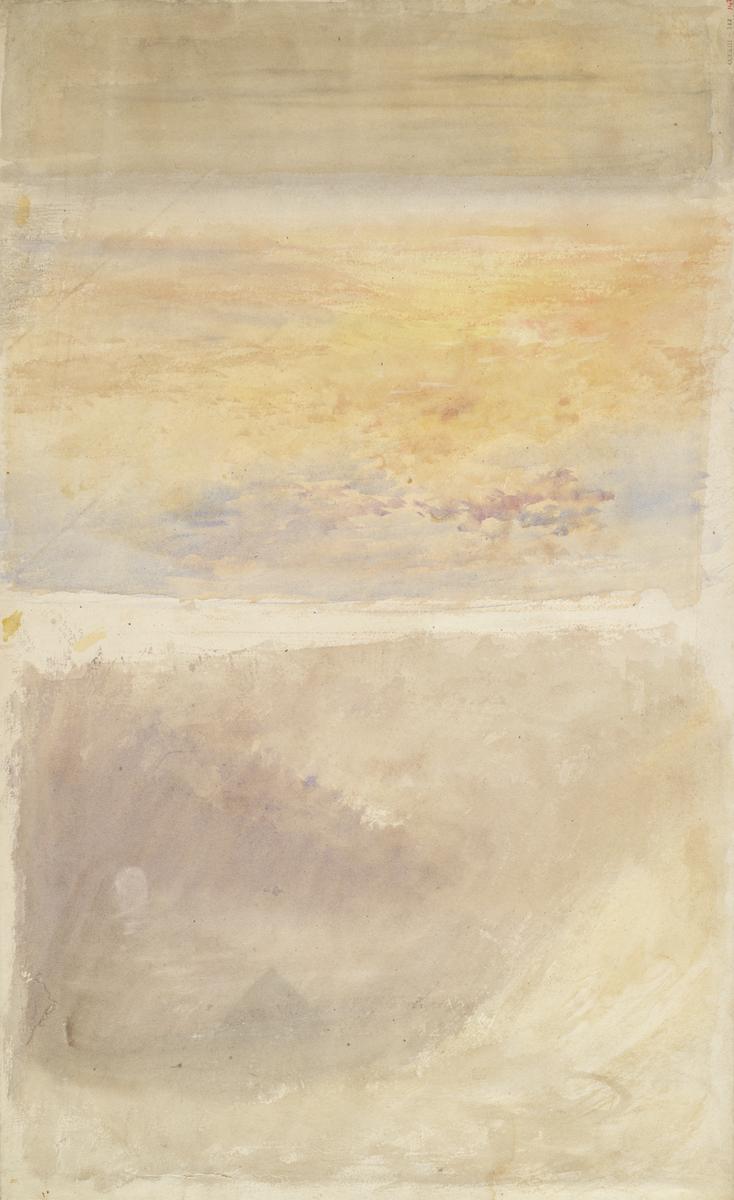Joseph Mallord William Turner Studies of the Moon over the Pyramids and Sunset Clouds over Stonehenge c.1822
Joseph Mallord William Turner,
Studies of the Moon over the Pyramids and Sunset Clouds over Stonehenge
c.1822
Joseph Mallord William Turner 1775–1851
Studies of the Moon over the Pyramids and Sunset Clouds over Stonehenge c.1822
D25264
Turner Bequest CCLXIII 142
Turner Bequest CCLXIII 142
Watercolour on white wove paper, 230 x 485 mm
Watermark ‘J Whatman | Turkey Mills | 1819’
Blind-stamped with Turner Bequest monogram towards top left and bottom right
Inscribed in red ink ‘142’ top right, ascending vertically
Stamped in black ‘CCLXIII – 142’ top right, ascending vertically
Watermark ‘J Whatman | Turkey Mills | 1819’
Blind-stamped with Turner Bequest monogram towards top left and bottom right
Inscribed in red ink ‘142’ top right, ascending vertically
Stamped in black ‘CCLXIII – 142’ top right, ascending vertically
Accepted by the nation as part of the Turner Bequest 1856
References
1820
A.J. Finberg, A Complete Inventory of the Drawings of the Turner Bequest, London 1909, vol.II, p.825, CCLXIII 142, as ‘The pyramid; also a study of sky’, c.1820–30.
1822
Eric Shanes, Turner’s Watercolour Explorations 1810–1842, exhibition catalogue, Tate Gallery, London 1997, pp.15, 97 Appendix I ‘Fawkes’, 99 Appendix I ‘Literary and Book Illustrations’, 102 Appendix I ‘Sky Sketches’, fig.3, as ‘Studies for frontispieces for Fawkes’s “Ancient and Modern Chronology”’, c.1822.
This tall sheet is an example of Turner’s sometimes working on two different ‘colour beginning’ compositions from opposite ends; such sheets have usually been divided subsequently. While Finberg recognised one of the subject as including a pyramid,1 Eric Shanes recognised the connection with specific works for his close friend and major patron Walter Fawkes of Farnley Hall in Yorkshire (see David Hill’s overall Introduction to the present section). In about 1822 Turner produced a pair of watercolours, The Pyramids – Ancient Chronology (private collection) and Stonehenge – Modern Chronology (private collection), as frontispieces for albums;2 Fawkes commissioned such works for a number of projects on historical and natural history themes,3 and the present sheet shows the development of Turner’s ideas for depictions of the mysterious ancient monuments.4
Turner had imagined the pyramids in his Biblical painting The Fifth Plague of Egypt, exhibited in 1800 (Indianapolis Museum of Art),5 where one is shown brilliantly lit at the centre against a violent storm; he later reworked the composition for the Liber Studiorum (see the entry for Tate D08120; Turner Bequest CXVI S), with three in a different arrangement, the nearest being in silhouette. The present sheet shows a small, dark triangle in the dim distance, while the pale, wave-like forms on the right may represent a second, brightly lit in the foreground, perhaps by the light of the setting sun behind the viewer which also appears to illuminate the rising moon on the left. The vagueness of the effect might indicate Turner experimenting with some idea of a storm or sandstorm, but in the final design the main pyramid is shown in sunlight, almost filling the composition and flanked by another on each side in the distance, its bulk emphasised by minute camels in the foreground and wisps of low cloud passing in front of the summit. Compare also The Pyramids at Gizeh, a watercolour of about 1832 (also Indianapolis Museum of Art)6 engraved in 1836 for Landscape Illustrations of the Bible (Tate impression: T05163), which is lit by a low full moon.
Turner had made a detailed survey of Stonehenge, on Salisbury Plain in Wiltshire, towards the end of his 1811 tour of the West Country, using both the Stonehenge sketchbook (Tate D41382–D41388; Turner Bequest CXXV b 9–15) and the Devonshire Coast, No.1 sketchbook (Tate D08749–D08752; Turner Bequest CXXIII 211a, 212, 212a, 213). See the present author’s introduction to the Stonehenge book for a detailed discussion of Turner’s other treatments of the famous megalithic monument.7 These include a ‘colour beginning’ (Tate D25123; Turner Bequest CCLXIII 1) showing only billowing clouds and sheep-like shapes on a plain curiously devoid of stones (like the present study),8 in preparation for the watercolour of about 1827 (Salisbury and South Wiltshire Museum),9 engraved as Stone Henge for the Picturesque Views in England and Wales in 1829 (Tate impressions: T04548, T04549, T06083).
In the finished watercolour for Fawkes’s album, the sun is shown very low, presumably setting beyond an unrealistically wide gap between the stones. The disregard for accuracy in favour of mood makes the intended orientation a matter of guesswork. As in the England and Wales design, accuracy is sacrificed for atmosphere.
Not separately catalogued in Andrew Wilton, J.M.W. Turner: His Life and Work, Fribourg 1979, but see p.449 under no.1247 for the pyramids subject; for both see the unpaginated Mellors & Kirk auction catalogue, Oxton, 26 May 1994 (254 and 253 respectively, reproduced in colour), reprised in Ian Warrell, ‘Salerooms Report’, Turner Society News, no.68, December 1994, p.12, reproducing only Stonehenge; see also Shanes 1997, figs.4 and 5 respectively, and Ian Warrell, Turner’s Wessex: Architecture and Ambition, exhibition catalogue, The Salisbury Museum 2015, figs.148 and 149 (colour) respectively.
See for example Wilton 1979, p.367, David Hill, Stanley Warburton, Mary Tussey and others, Turner in Yorkshire, exhibition catalogue, York City Art Gallery 1980, pp.49–51, David Hill and Michael Densley, Turner’s Birds: Bird Studies from Farnley Hall, [exhibition catalogue] Leeds City Art Gallery 1988, Anne Lyles, Turner and Natural History: The Farnley Project, exhibition catalogue, Tate Gallery, London 1988, and Warrell 2015 pp.145, 150.
Technical notes:
The moon in the pyramid subject has been washed out or perhaps lifted out using a fingertip.
Verso:
Blank; laid down.
Matthew Imms
September 2016
How to cite
Matthew Imms, ‘Studies of the Moon over the Pyramids and Sunset Clouds over Stonehenge c.1822 by Joseph Mallord William Turner’, catalogue entry, September 2016, in David Blayney Brown (ed.), J.M.W. Turner: Sketchbooks, Drawings and Watercolours, Tate Research Publication, December 2016, https://www

